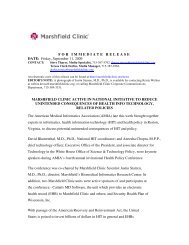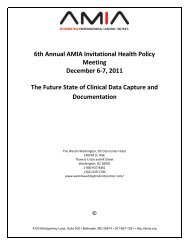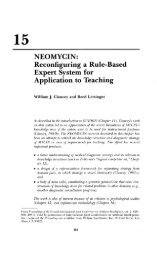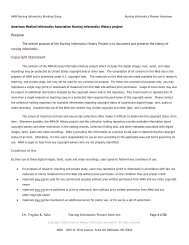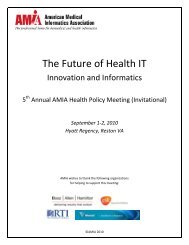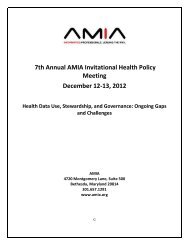Rule-Based Expert Systems: The MYCIN Experiments of ... - AITopics
Rule-Based Expert Systems: The MYCIN Experiments of ... - AITopics
Rule-Based Expert Systems: The MYCIN Experiments of ... - AITopics
Create successful ePaper yourself
Turn your PDF publications into a flip-book with our unique Google optimized e-Paper software.
138 Details <strong>of</strong> the Revised <strong>The</strong>rapy Algorithm6.3<strong>The</strong> Explanation CapabilityWe will now consider how the structure <strong>of</strong> the algorithm is exploited toproduce simple explanations. A sample question about therapy selectionis shown in Figure 6-3. <strong>The</strong> medical decisions that were applied to thedrug chloramphenicol are listed as a logical sequence <strong>of</strong> reasons, which isproduced by retrieving and printing traces that were left behind by theprogram. <strong>The</strong> trace retrieval program is termed CHRONICLER becauseits explanations consist <strong>of</strong> a chronicle <strong>of</strong> decision events.** WHY DID YOU’GIVE CHLORAMPHENICOL FOR E.COLI IN REC-I?CHLORAMPHENICOL was proscribed for ITEM-2 in RECOMMENDATION-1 :Since -- CHLORAMPHENICOL is a treatment <strong>of</strong> choice for e.coli in meningitis-- ITEM-2 is sensitive to CHLORAMPHENICOL-- there were no contraindications for itCHLORAMPHENICOL was prescribed because it was part <strong>of</strong> therecommendation that covers for all <strong>of</strong> the items, using the fewest number<strong>of</strong> drugs.FIGURE 6-3 A question concerning why a drug was prescribed.(User’s input follows the double asterisks.)Figure 6-4 shows the general organization <strong>of</strong> the Explanation System.<strong>The</strong> traces (discussed below) constitute a dynamic event history. A chronicle<strong>of</strong> events is printed by using a process transition diagram to selectivelyretrieve the relevant traces.Figure 6-5 shows the kind <strong>of</strong> transition diagramwe use to representthe steps <strong>of</strong> therapy selection. <strong>The</strong> states roughly correspond to the generateand test steps shown in Figure 6-1. <strong>The</strong> arrows are labeled as positive(pos) and negative (neg) criteria (i.e., criteria that support or opposerecommendation <strong>of</strong> a given drug). <strong>The</strong>se correspond to the medical strategies,e.g., "<strong>The</strong> drug is on the treatment-<strong>of</strong>-choice list for the organism(the initial list) and so was considered to cover for the organism." If a drugis prescribed, there must be a sequence <strong>of</strong> positive criteria leading fromthe first state to the output state. <strong>The</strong>se are the reasons <strong>of</strong>fered the useras an explanation for prescribing the drug. To make the explanationclearer, the states are reordered into three groups (planning criteria, testingcriteria, and generate and output criteria) to conform to the followinggeneral scheme:Since----
<strong>The</strong> Explanation Capability 139I<strong>MYCIN</strong>PROGRAMIRecordsleftbehind.I(dynamic)EventHistory(static)TRANSITIONDIAGRAMEventStructureAnswer toQuestionFIGURE 6-4 Organization <strong>of</strong> the Explanation System.(therefore)On the other hand, ifa drug is not prescribed, there must be a negativecriterion to explain why it dropped out <strong>of</strong> contention if it was on the initiallist. Failure to prescribe can be caused by either failure to consider theposcnteriaSTATE-1 ~ STATE-2.poscnteriaSTATE-3 ’’ " ~ STATE-N{goal}neg criterianeg criteriaSTATE-2(final}STATE-3(final}FIGURE 6-5 <strong>The</strong> state transition diagram.
140 Details <strong>of</strong> the Revised <strong>The</strong>rapy Algorithm** WHY DIDN’T YOU SUGGEST PENICILLIN IN REC-1 FOR STAPH-COAG+?PENICILLIN was not prescribed for ITEM-1 in RECOMMENDATION-1 :PENICILLIN was discounted for ITEM-1 because it is NOT DEFINITE that the item is sensitive to this drug.<strong>The</strong>re are other potential therapies under consideration which are much more desirable, viz., current therapiesor drugs to which the item is definitely sensitive.Would you like to see some details? ** YES<strong>The</strong> drugs to which the staphylococcus-coag-pos is sensitive are: cephalothin (1.0) vancomycin (1.0)gentamycin (1.0) tobramycin (1.0) erythromycin-and-tetracycline (1.0) chloramphenicol-and-erythromycin(1.0)[RULE098 RULE445]Would you like to know about the history <strong>of</strong> PENICILLIN in the decisionprocess up to this point? ** YES-- PENICILLIN is a treatment <strong>of</strong> choice for staphylococcus-coag-pos in meningitis. But as explained above,PENICILLIN was discounted.FIGURE 6-6 Question concerning why a drug was not prescribed.drug (plan) or failure <strong>of</strong> a test. A third possibility is that the drug wasn’tpart <strong>of</strong> an acceptable recommendation, but was otherwise a plausible choice(when considered alone). In this case, the drug needs to be consideredthe context <strong>of</strong> a full recommendation for the patient. 3 (See Figure 6-9 foran example.)Figure 6-6 shows an example <strong>of</strong> a question concerning why a drug wasnot prescribed. In response to a question <strong>of</strong> this type, the negative criterionis printed and the user is <strong>of</strong>fered an opportunity to see the positive decisionsaccrued up to this point. In this example we see that penicillin wasnot prescribed because it is not definite that the item is sensitive to thisdrug. That is the negative criterion. <strong>The</strong> fact that penicillin was a potentialtreatment <strong>of</strong> choice permitted its transition to the reranking step. 4 This isshown in Figure 6-7. When <strong>MYCIN</strong>’s rules (as opposed to Interlisp code)are used to make a transition decision, we can provide further details, asshown in Figure 6-6.For questions involving two drugs, e.g., "Why did you prescribe chloramphenicolinstead <strong>of</strong> penicillin for Item-l?", CHRONICLER is invokedto explain why the rejected drug was not given. <strong>The</strong>n the user is <strong>of</strong>feredthe opportunity to see why the other drug was given.To summarize, <strong>MYCIN</strong> leaves behind traces that record the application3Events are recorded as properties <strong>of</strong> the drugs they involve. <strong>The</strong> trace includes other contextssuch as the item being considered. To deal with iteration, events are <strong>of</strong> two types: enduringand pass-specific. Enduring events represent decisions that, once made, are never reconsidered,e.g., the initial ranking <strong>of</strong> drugs tbr each organism. Pass-specific events may not figure in thefinal result; they may indicate computation that ~ailed to produce a solution, e.g., proposinga drug as part <strong>of</strong> a specific recommendation. Thus traces are accessed by drug name and thecontext <strong>of</strong> the computation, including which pass <strong>of</strong> the generate-and-test process producedthe final solution.4penicillin is given for staph-coag + only if the organism is known to be sensitive to that agent.
Comparing Alternative Recommendations 141v initial"treatment <strong>of</strong> choice"I~ plan1v¯ plan2~ ¯. ¯1"item not sensitive"plan2{final}FIGURE 6-7 Trace history for the question shown in Figure6-6.<strong>of</strong> the positive and negative criteria. <strong>The</strong> Explanation System uses a statetransition diagram that represents the steps <strong>of</strong> the algorithm to retrievethe relevant traces in a logical order.It is interesting to note that CHRONICLER is described well by Bobrowand Brown’s synthesis, contingent knowledge, and analysis (SCA) paradigmfor understanding systems (Bobrow and Brown, 1975). Contingentknowledge is a record <strong>of</strong> program-synthesized observations for later useby an analysis program to answer questions or comment on the observedsystem. In CHRONICLER the traces and transition diagram constitute thecontingent knowledge structure. Synthesis (abstraction <strong>of</strong> results) is performedby the therapy selector as it classifies the drugs in the variousdecision steps and records its "observations" in traces. Analysis is performedby CHRONICLER as it "reads" the traces, interpreting them interms <strong>of</strong>" the state transition diagram. <strong>The</strong> meteorology question-answeringsystem described by Brown et al. (1973) uses a similar knowledge representation.6.4Comparing Alternative Recommendations<strong>The</strong> therapy program will print alternative recommendations if asked todo so. This is done by eliminating drugs from contention and rerunningthe algorithm. Figure 6-8 shows an example <strong>of</strong> an alternative recommendationand a comparison <strong>of</strong> this alternative to the algorithm’s first choice.<strong>The</strong> comparison is made by simply reducing the recommendations to canonicalform and then determining their relative ranking in the list <strong>of</strong> instructions.A recommendation is better than another when it reduces to abetter instruction, i.e., when the preference description <strong>of</strong> its drugs appearsearlier in the fixed list <strong>of</strong> instructions. It is also possible that the comparison
142 Details <strong>of</strong> the Revised <strong>The</strong>rapy AlgorithmDo you wish to see the next choice therapy?** YESWhich, if any, <strong>of</strong> the above drugs do you wish eliminated fromconsideration?**CHLORAMPHENICOL[REC-2] Next bestherapy recommendation:In order to cover for Items :Give: GENTAMICINIn order to cover for Item :Give: METHICILLINRECOMMENDATION-2 is substantially inferior to RECOMMENDATION-1 (becauseit requires more drugs or drugs that are not as good).Would you like to see details <strong>of</strong> this comparison?** YESLooking at the coverage <strong>of</strong> the ’most likely’ items, we see that:RECOMMENDATION-1 consists <strong>of</strong> 1 first choice drug(CHLORAMPHENICOL for ITEM-2 and ITEM-3) and I second choice drug(GENTAMICIN for ITEM-3 and ITEM-t)RECOMMENDATION-2 consists <strong>of</strong> 1 first choice drug (METHICILLINfor ITEM-l) and 1 third choice drug (GENTAMICIN for ITEM-2 andITEM-3)Do you wish to see the next choice therapy?** NOFIGURE 6-8 Comparing alternativerecommendations.will be a "close call," because one <strong>of</strong> the recommendations might use betterdrugs for the most likely organisms but cover for fewer <strong>of</strong> the less likelyorganisms. Again, it is the ability to encode output canonically that givesus the ability to make such a direct comparison <strong>of</strong> alternatives.6,5Evaluating a User’s Choice <strong>of</strong> <strong>The</strong>rapy<strong>The</strong> comparison described above is useful to a physician who prefers togive therapy other than <strong>MYCIN</strong>’s first choice and wishes to know if theprogram truly considers it to be suboptimal therapy. However, it is tediousfor the user to request all possible alternatives to be printed, so we <strong>of</strong>ferthe user the opportunity to enter his or her own choice <strong>of</strong> drugs for theorganisms that require therapy (Figure 6-9).Each drug the user suggests for an item is first formed into a standardinternal question for CHRONICLER: "Why wasn’t prescribed for?" If there is a negative criterion about this drug for this item inthe event history, it is printed and the user is given the option <strong>of</strong> selectinganother drug.
Evaluating a User’s Choice <strong>of</strong> <strong>The</strong>rapy 143** WHY DIDN’T YOU GIVE AMPICILLIN-AND-GENTAMICIN FOR E.COLI IN REC-I?AMPICILLIN-AND-GENTAMICIN was not prescribed for ITEM-2 inRECOMMENDATION-1 :AMPICILLIN-AND-GENTAMICIN is a plausible choice for e.coli inmeningitis, and was not explicitly rejected for use against ITEM-2 inRECOMMENDATION-1. However, the best therapy did not includeAMPICILLIN-AND-GENTAMICIN.If you would like to suggestherapy which includesAMPICILLIN-AND-GENTAMICIN, your regimen will be compared to <strong>MYCIN</strong>’s,Would you like to do this? ** YESFor each item in turn, enter the drug you would have prescribed inFIECOMMENDATION-1.In order to minimize the number <strong>of</strong> drugs in your recommendation, you maynot wanto prescribe therapy for every item. Items which representhemost likely organisms are indicated with a plus sign (+).+ ITEMol -- the staphylococcus-coag-pos ** GENTAMIClN+ ITEM-2 -- the e.coli ** AMPICILLIN GENTAMICIN+ ITEM°3 -- the klebsiella-pneumoniae ** GENTAMICIN+ ITEM-4 -- the pseudomonas-aeruginose **[Checking for contraindications...][Considering AMPICILLIN-AND-GENTAMICIN for use against iNFECTION-1 ...][No contraindications found...][Now comparing your prescription to <strong>MYCIN</strong>’s...]Perhaps you did not realize that one <strong>of</strong> the drugs you prescribed,GENTAMICIN, will cover for ITEM-4, an item for which you did notprescribe therapy. I have changed your prescription accordingly.ORGANISMS Your regimen <strong>MYCIN</strong>’s regimenDrug -- Choice Drug -- Choice"most likely"ITEM-3 GENTAMICIN -- 3rd CHLORAMPHENICOL-AND-GENTAMICIN -- 1stITEM-2 AMPICILLIN-AND- CHLORAMPHENICOL-- 1stGENTAMICIN -- 1stITEM-1 GENTAMICIN -- 2nd GENTAMICIN -- 2nd"less likely"ITEM-4 GENTAMICIN -° 2nd GENTAMICIN -- 2nd(<strong>The</strong> desirability <strong>of</strong> a drug is defined to be its lowest ranking for theitems it covers.)Both prescriptions include fewer than 3 drugs, so we must look at howhighly ranked each prescription is for the most likely organism(s).Your prescription <strong>of</strong> 1 first choice drug (AMPICILLIN for ITEM-2) andthird choice drug (GENTAMICIN for ITEM-3) is not as good as <strong>MYCIN</strong>’sprescription <strong>of</strong> 1 first choice drug (CHLORAMPHENICOL for ITEM-2 andItem-3) and 1 second choice drug (GENTAMICIN for ITEM-l).[You may refer to your regimen as RECOMMENDATION-2 in later questions.]FIGURE 6-9 Evaluating a user’s choice <strong>of</strong> therapy.
144 Details <strong>of</strong> the Revised <strong>The</strong>rapy AlgorithmOnce the user has supplied a set <strong>of</strong> drugs to cover for all <strong>of</strong> the mostlikely organisms, his or her proposal is tested for the criteria <strong>of</strong> drug classuniqueness and patient-specific factors (described in Section 6.2.4). If theproposal is approved, this recommendation is compared to the program’schoice <strong>of</strong> therapy, just as the program compares its alternatives to its ownfirst-choice recommendation. 5 It is also possible to directly invoke the therapycomparison routine.6.6Some Unsolved Problems<strong>The</strong>re are a number <strong>of</strong> improvements that could be made to this system.Among the most important to potential users is a more flexible questionformat. In our experience physicians tend to address short, unspecificquestions to the program, e.g., "Why ampicillin?" or "What happened toE. coli?" Processing these questions will require a fairly sophisticated preprocessorthat can help the user define such a question more precisely, orat least make some plausible assumptions.Second, we anticipate the need to explain the heuristics, which noware describable only in a template form. 6 A user might like to know whata "drug sensitivity" is or why a heuristic was not used. Providing simple,fixed-text definitions is easy, but discussing a particular heuristic to theextent <strong>of</strong> explaining why it was not applicable is well beyond the capabilities<strong>of</strong> this Explanation System. One possible solution is to represent the heuristicsinternally in a rulelike form with a set <strong>of</strong> preconditions in programreadablepredicates, like <strong>MYCIN</strong>’s rules. We could then say, for example,that a drug was lowered in rank because its sensitivity was "intermediate,"even though it was a current therapy (which would otherwise be reasonfor continuing to prescribe it). Thus we would be splitting a medical criterioninto its logical components. Moreover, human explanations sometimesinclude hypothetical relations that have important instructional benefit,e.g., "If all <strong>of</strong> the drugs had been intermediate, then this currenttherapy would have been given preference." In general, paraphrasing explanations,explaining why an event failed to take place, and relating decisionsare difficult because they require some representation <strong>of</strong> what theheuristics mean. Providing a handle on these underlying concepts is a farcry from a system that can only fill in templates.Third, it is important to justify the medical heuristics and initial pref-5<strong>The</strong> explanations at this point are more pedagogical than those supplied when the prugramcompares its own alternatives. It seems desirable to phrase comparisons as positively as possibleto avoid irritating the user.6That is, each medical heuristic has a string with blanks associated with it, e.g., "wasdiscounted for" "because it was not definite that the item was sensitive to this drug."
Conclusions 145erence ranks for drugs. We now provide text annotations that include referencesand comments about shortcomings and intent.Finally, we could further develop the tutorial aspects <strong>of</strong> the ExplanationSystem. Rather than passively answering questions, the ExplanationSystem might endeavor to teach the user about the overall structure andphilosophy <strong>of</strong>" the program (upon request!). For example, a user mightappreciate the optimality <strong>of</strong> the results better if he or she understood theseparation <strong>of</strong> factors into local and global considerations. Besides explainingthe results <strong>of</strong> a particular run, an Explanation System might characterizeindividual decisions in the context <strong>of</strong> the program’s overall design.Parts Six and Eight discuss the issues <strong>of</strong> explanation and education in moredetail.6.7 ConclusionsWe have developed a system that prescribes optimal therapy and is able toprovide simple, useful explanations. <strong>The</strong> system is based on a number <strong>of</strong>design ideas that are summarized as follows:1. separate the local and global optimality criteria;2. apply these criteria in comprehensible steps--a generate-and-test controlstructure was found to be suitable;3. justify selected therapies by using canonical descriptions thata. juggle several global criteria at once, andb. permit direct comparison <strong>of</strong> alternatives; and4. exploit the simple control structure by using a state transition diagramto order retrieval <strong>of</strong> traces.In addition,factors:the Explanation System has benefited from a few simplifying1. <strong>The</strong>re are relatively few traces (fewer than 50 drugs to keep track <strong>of</strong>and fewer than 25 strategies that might be applied).2. <strong>The</strong>re is a single basic question: Why was (or was not) a particular drugprescribed for a particular organism?While this therapy selection algorithm may appear straightforward, itis the product <strong>of</strong> trying to codify an unstructured list <strong>of</strong> factors presentedby physicians. <strong>The</strong> medical experts did not order these considerations andwere not sure how conflicting constraints should be resolved. <strong>The</strong> frameworkwe imposed, namely, invoking optimality criteria locally and globally
146 Details <strong>of</strong> the Revised <strong>The</strong>rapy Algorithmwithin a generate-and-test control structure and describing output canonically,provided a language that enabled us to codify the physicians’judgments,thereby significantly improving the performance and manageability<strong>of</strong> the program.Moreover, this well-structured design enables us to print simple explanations<strong>of</strong> the program’s decisions and to compare alternative solutions.We have provided this facility because we want the program to be usedintelligently. If a user is confused or disagrees with the optimality criteria,we expect him or her to feel free to reject the results. <strong>The</strong> explanationsystem we have provided is intended to encourage thoughtful use <strong>of</strong> thetherapy selection program.



